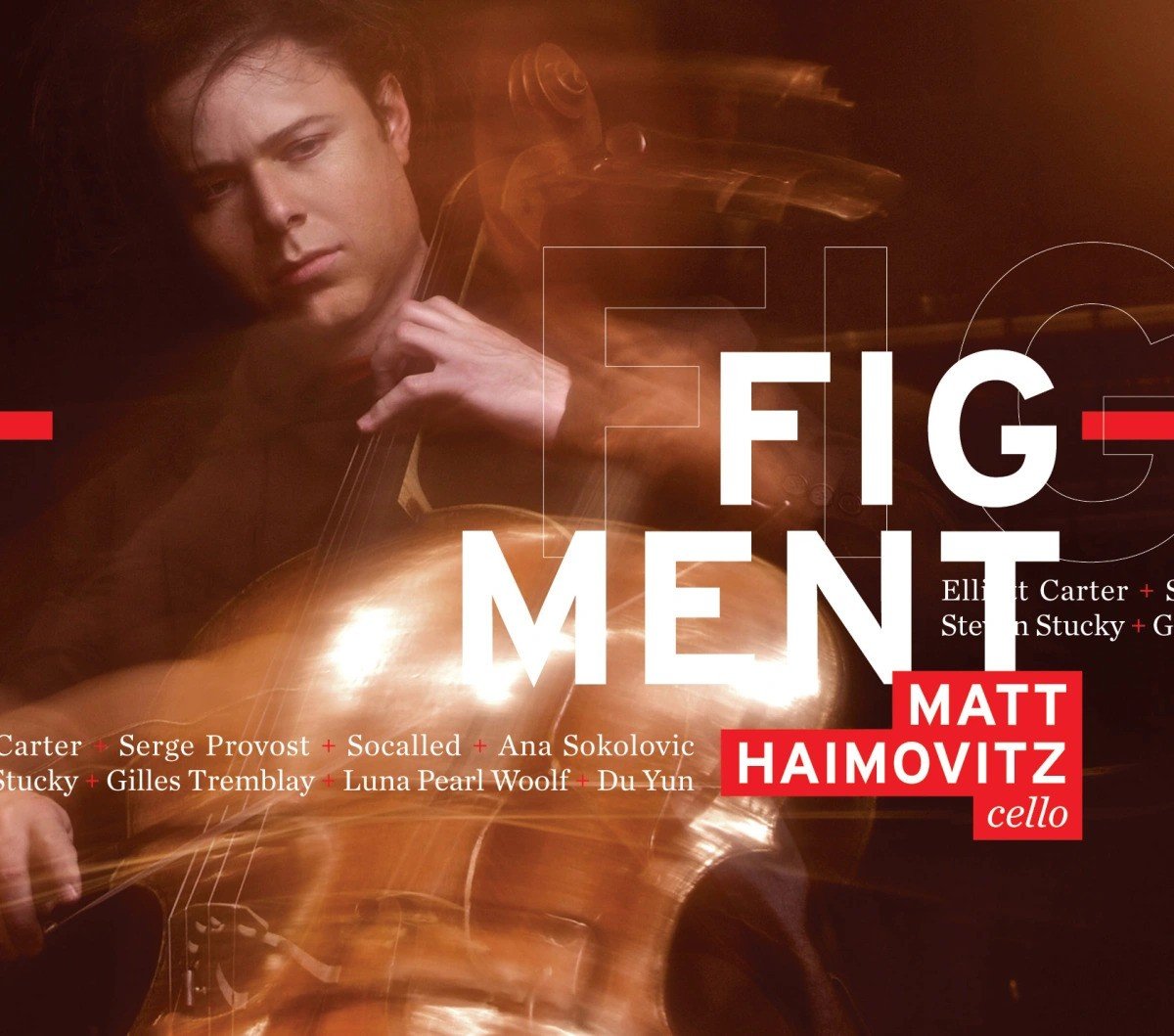Figment
A sequel to his 50-State solo cello tour and recording, Anthem, released in 2003, Figment is a return to Haimovitz’s signature solo set, embracing the musical communities of his two home countries, the US and Canada. Inspired by centenarian composer Elliott Carter and his two Figments for solo cello, the new program brings together a wide range of important new music for cello and electronics by leading and emerging North American composers. From the Middle Eastern microtones of Gilles Tremblay’s Threnody for Lebanon to Ana Sokolovic’s Balkan folk-influenced Vez, from Serge Provost’s cutting-edge Les Vertiges de S. for electronically-processed solo cello to up and coming composer/songstress Du Yun’s San, a deconstruction of haunting ancient Chinese fragments, Figment embraces the diversity of our collective experience. The program, which also includes music by Steven Stucky, Luna Pearl Woolf, and composer/producer Socalled, celebrates innovative North American composers who seek a renewed lyricism and epitomize a new era of hope and creativity in the face of challenging times.
-
Figlude
Figment
Vez
Les Vertiges de S.
Cèdres en voile : thren pour le Liban
Dialoghi
San
Sarabande
Figment no. 2: Remembering Mr. Ives
Miranda
-
In the composers own words:
FIGMENT
The idea of composing a solo cello piece had been in the back of my mind for many years, especially since so many cellists had been urging me to do so. When Thomas Demenga asked me for such a work, at my 1994 85th birthday concert in Basel, to be premiered at a concert he was giving in New York City sponsored by the Naumburg Foundation, I promptly set to work. Demenga had already impressed me greatly, when he played some of my chamber works at my 80th birthday concert in Badenweiler, Germany, and especially by his wonderful recording of these works issued under the ECM RECORDS New Series.
“Figment” for solo cello presents a variety of contrasting, dramatic moments using material derived from a single musical idea.
Elliott Carter (1994)
VEZ
Vez in Serbian means embroidery, needlework. The piece is inspired by traditional Balkan music. Repeated notes, irregular rhythms and tiny “embroidery” between accented structural pitches are in the main features of this piece.
Vez is a commission from the CBC for Yegor Dyachkov to whom it is dedicated.
Ana Sokolovic
LES VERTIGES DE S.
En 1936, S. a douze ans, elle est pensionnaire chez les Dames de S.-A.. Comme personne ne vient presque jamais la voir, les jours de visite elle est gardienne du parloir… Dans un petit carnet noir, elle note, tous les jours, ses impressions, ses idées, puis elle plonge passionnément dans les livres. C’est ainsi que sa solitude s’est transformée en un voyage sans limites dans le temps ou l’espace. Quand elle ne lit pas elle chante. Dans les moments de silence, au parloir lorsque les visiteurs se sont retirés, à la chapelle après les offices, ou au jardin… elle est parfois prise de vertiges soudains, suscités par le surgissement de tel passage d’un poème, d’un récit, d’une musique… des appels pressants vers… ailleurs.
S. nous a quitté depuis longtemps déjà. Cette œuvre est un écho des vertiges de la petite fille qui vécut ailleurs.
Serge Provost
DIALOGHI
Among composers there is an old tradition of honoring patrons or friends by incorporating their names into the fabric of the music. One version is the soggetto cavato (carved subject) of Renaissance music. Later examples include the BACH motif, D.Sch. as the personal symbol of Shostakovich, and the coded names in Schumann’s piano music.
Dialoghi (Dialogues) was written as a gift to a friend, the American cellist Elinor Frey. Its theme is the six letters of her first name, translated into notes: E, L (= la, or A), I (= mi, or E), N (= G, according to one often-used system), O (= do, or C), and R (= re, or D) — hence the work’s subtitle, “Studi su un Nome,” studies on a name. The music unfolds in seven short, vividly contrasting variations. Since the name-theme uses only five different notes, namely the pentatonic C, D, E (twice), G, and A, many of the variations juxtapose these five with other, contrasting combinations drawn from the remaining seven notes of the chromatic scale. The last variation leads to a grand restatement of the theme but then subsides into a serene coda.
Why “dialogues”? Partly because the theme notes and the non-theme notes so often engage in “conversation” throughout, but more importantly because the friendship being recognized in this piece rested not only on my musical collaborations with Elinor but also on our conversations about books, music, paintings, films, psychology, religion, food, and all things Italian (hence the Italian title).
Dialoghi was composed in October 2006 and was given its first public performance by its dedicatee in Cazenovia, New York, on 14 July 2007.
Steven Stucky
SAN
Not unlike turning things inside out, San’ is my inner hearing of the ancient Chinese ‘chin’ piece Guang Ling San which is known for its underlying nobleness, due to the serial stories/metaphors associated with the piece. Using the computer to patch events together, my inner hearing is thus amplified; and at times, the tiny nuance that my inner listening field responded to, is tuned into a great happening in the piece.
It was in the year 262 A.D. when “Guang Ling San” was first publicly played by Ji Kang – right before his own public execution; the first written notation of the piece was then found in 1425 A.D., exactly eleven hundred sixty three years later. In today’s time, what has remained in the music is ambiguous. The idea of tossing around the listening perception (my turning the original piece into my own listening reception, the performer’s interpretation, and the listener’s individual remembrance of this hearing) speaks an attempt of:
the shared visceral, the absent contexture.
Du Yun 2003
FIGMENT NO. 2 (REMEMBERING MR. IVES)
Figment No. 2 was composed in the spring of 2001 as a present for the wonderful American cellist Fred Sherry who with his outstanding instrumental and organizational abilities and his boundless enthusiasms has done so much for music.
-
Release Date: September 27, 2009
Label: Oxingale Records (OX2016)
Artist(s): Matt Haimovitz, duYun
Composer(s): Socalled, Elliot Carter, Ana Sokolovic, Serge Provost, Gilles Tremblay, Steven Stucky, Du Yun, Luna Pearl Woolf

